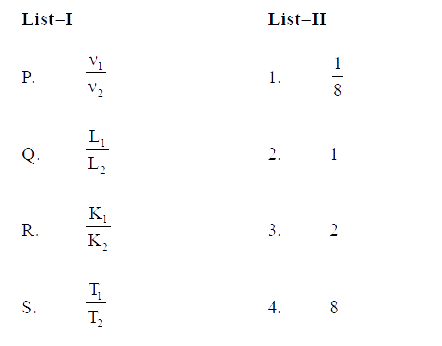If , respectively , denote energy , mass , angular momentum , and gravitational constant , then has the dimensions of
length
angle
mass
time
The correct Answer is:B
Step by step video & image solution for If E , M , J , and G , respectively , denote energy , mass , angular momentum , and gravitational constant , then EJ^(2) //M^(5) G^(2) has the dimensions of by Physics experts to help you in doubts & scoring excellent marks in Class 12 exams.
Updated on:21/07/2023Topper's Solved these Questions
- UNITS, MEASUREMENTS & ERRORSBook:VMC MODULES ENGLISHChapter:UNITS, MEASUREMENTS & ERRORSExercise:Impeccable
Explore 51 Videos
- UNITS, MEASUREMENTS & ERRORSBook:VMC MODULES ENGLISHChapter:UNITS, MEASUREMENTS & ERRORSExercise:Illustration
Explore 24 Videos
- UNITS, MEASUREMENTS & ERRORSBook:VMC MODULES ENGLISHChapter:UNITS, MEASUREMENTS & ERRORSExercise:Enable
Explore 50 Videos
- SYSTEM OF PARTICLES AND ROTATIONAL MOTIONBook:VMC MODULES ENGLISHChapter:SYSTEM OF PARTICLES AND ROTATIONAL MOTIONExercise:IMPECCABLE
Explore 56 Videos
- WAVE MOTIONBook:VMC MODULES ENGLISHChapter:WAVE MOTIONExercise:JEE ADVANCED ARCHIVE LEVEL 2 (TRUE FALSE TYPE)
Explore 4 Videos
Similar Questions
If E, M, L and G denote energy, mass, angular momentum and gravitational constant repectively then the quantity (E2L2/M5G2) has the dimensions of :-
View SolutionIn the expression P=EL2m−5G−2, E, m, L and G denote energy, mass, angular momentum and gravitational constant, respectively. Show that P is a dimensionless quantity.
View SolutionIf J is the angular momentum and E is the kinetic energy, then J2E has the dimensions of
View Solutionh d G has the dimensions of (h = height , d = density , G = Gravitational constant)
View SolutionIf E = energy , G= gravitational constant, I=impulse and M=mass, then dimensions of GIM2E2 are same as that of
View SolutionThe escape velocity of a sphere of mass m is given by (G= univesal gravitational constant, Me= mass of the earth and Re= radius of the earth)
View SolutionKepler's third law states that square of period revolution (T) of a planet around the sun is proportional to third power of average distance i between sun and planet i.e. T2=Kr3
here K is constant
if the mass of sun and planet are M and m respectively then as per Newton's law of gravitational the force of alteaction between them is F=GMmr2, here G is gravitational constant. The relation between G and K is described as
View SolutionA planet of mass M, has two natural satellites with masses m1 and m2. The radii of their circular orbits are R1 and R2 respectively. Ignore the gravitational force between the satellites. Define v1,L1,K1 and T1 to be, respectively, the orbital speed, angular momentum, kinetic energy and time period of revolution of satellite 1 , and v2,L2,K2 and T2 to be he corresponding quantities of satellite 2. Given m1/m2=2 and R1/R2=1/4, match the ratios in List-I to the numbers in List-II.

View SolutionThe acceleration due to gravity at a piece depends on the mass of the earth M, radius of the earth R and the gravitational constant G. Derive an expression for g?
View SolutionThe relation between angular momentum J of a body and rotational kinetic energy is given by J=√2EI. The graph between J and √E will be:
View Solution